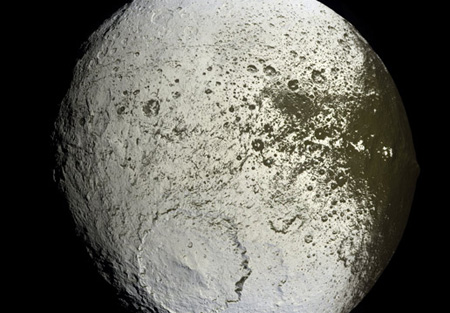Original URL: https://www.theregister.com/2007/10/09/moon_dark_side/
Sun to blame for yin-yang Moon's dark side
Paging Pink Floyd
Posted in Science, 9th October 2007 12:53 GMT
The fearsome heat of the Sun is being blamed for the strange yin-yang appearance of Saturn's moon Iapetus.
Even at an average distance of roughly 1.5 billion kilometres from the sun, Iapetus is being gradually toasted on one side.

False colour image of Iapetus' bright leading edge. Credit: NASA
NASA says its infrared observations confirm that the dark side is warm enough for a very slow but sustained release of water vapour, and that the temperature difference between the two hemispheres is a major factor in the sharp colour boundary.
Researchers have suspected for a while that some external event caused one side of the Moon to become darker. Tilmann Denk, Cassini imaging scientist at the Free University in Berlin, explains: "Dusty material spiralling in from outer Moons hits Iapetus head-on, and causes the forward-facing side of Iapetus to look different than the rest of the Moon."
This idea has not been discarded, but the scientists think the difference set up a vicious circle, leading to an ever greater contrast between the two sides of the Moon.
The process is simple to explain in broad brush terms. Once the Moon was darkened slightly on the leading edge, the side facing towards the Sun, the surface there would heat more rapidly. As the surface heats, the water ice evaporates and condenses on the nearest cold spot. As the leading edge loses its ice, it gets darker still, retaining more heat and setting up a runaway process whereby the dark side gets darker and darker and the bright side brighter.
The hypothesis even stands up to more detailed examination. In the picture, we can clearly see isolated spots of dark material even on the bright side of the Moon. But NASA says analysis of these spots shows them to be predominantly on the sunward facing slopes of craters.
Some craters have darker material at the bottoms of the slopes, suggesting that it might even slide downhill.
But the dark material is still a mystery. The initial darkening event is still unknown, and scientists are no closer to discovering exactly what the dark material is. So as Cassini flies through Saturn's system, there is still plenty more to come, the scientists say. ®